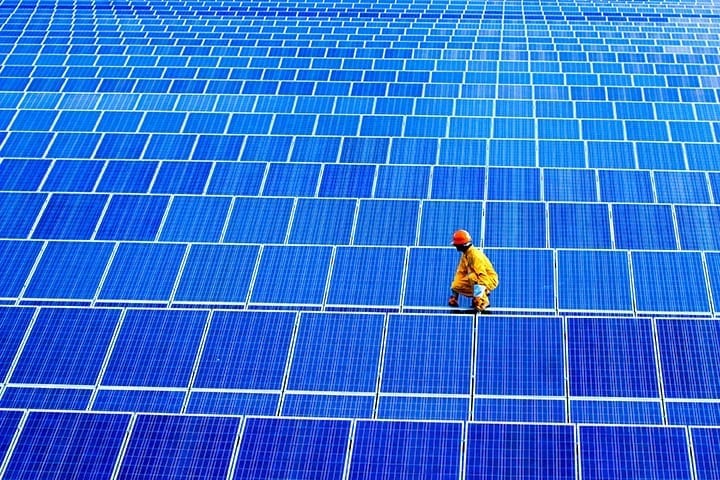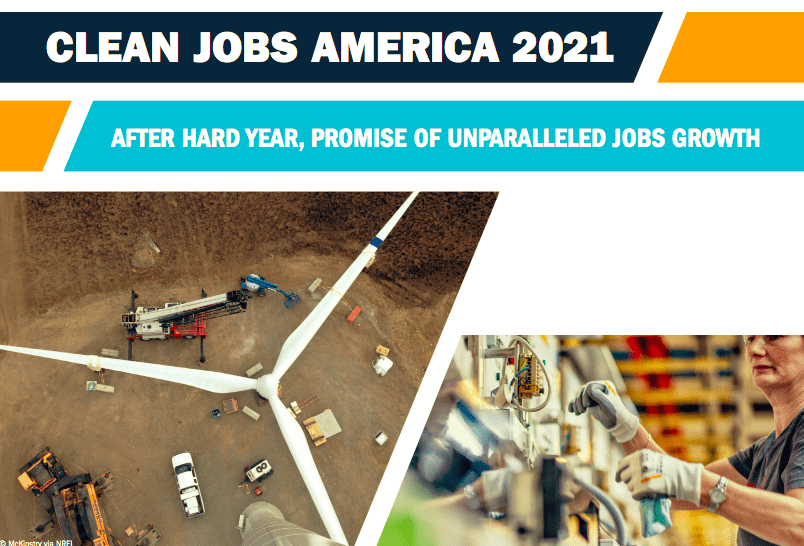COVID Costs 300,000 Clean Energy Jobs; DOE Readies for Rebound
The post COVID Costs 300,000 Clean Energy Jobs; DOE Readies for Rebound appeared first on POWER Magazine.

An analysis of Bureau of Labor Statistics data for 2020 shows the number of workers in clean energy jobs last year fell for the first time since 2015, according to a group of business leaders and investors who study those numbers each year.
The group's Clean Jobs America" report, released April 19, said about 3 million U.S. workers were employed in the clean energy sector at year-end 2020, down from 3.36 million in 2019. The group said the COVID-19 pandemic, its related economic contraction, and Trump administration policies that encouraged fossil fuels over clean energy" contributed to a year-over-year loss of more than 300,000 jobs in energy efficiency, solar, wind, and other clean energy sectors.
The Clean Jobs America" report is produced by E2-short for Environmental Entrepreneurs-a national group of business leaders, investors, and others who advocate for policies they consider good for the economy and the environment. David Turk, deputy secretary for the U.S. Department of Energy (DOE), discussed the report along with representatives of E2 and BW Research Partnership during an online media briefing Monday. Turk said the DOE is ready to provide $300 billion to support manufacturing in the U.S. clean energy sector.
The 2021 report looks at the impact of the COVID-19 pandemic on the clean energy industry. It also details what the Biden administration's American Jobs Plan means for employment in the clean energy sector, including solar, wind, energy efficiency, electric vehicles, and more. The report covers all 50 states and the District of Columbia.
 The Clean Jobs America" report released April 19 provides a blueprint for creating more jobs in the clean energy sector. Courtesy: E2
The Clean Jobs America" report released April 19 provides a blueprint for creating more jobs in the clean energy sector. Courtesy: E2The critical point is that clean energy isn't just good for the planet, it's a boon for our economy," said Turk. This report shows the enormous impact of clean energy jobs across the country. And it shows the enormous potential going forward for job creation. Even as we're grappling with economic crisis from the global pandemic, clean energy jobs are outpacing the rest of the economy."
Political DebateThe report acknowledged the political arguments inherent for the energy sector, particularly between proponents of policies benefiting renewable energy, and those supporting thermal power generation at a time when many parts of the U.S. still depend on jobs in the fossil fuel industry.
We're confident the future of clean energy is full with job growth. And we're going to make sure it's union job growth," Turk said. We're focused not only on the quantity of jobs, but on the quality of those jobs. It's going to require a lot of focus and a lot of discipline to ensure that clean energy jobs can lift up anyone, anywhere, across the country. I think everyone has heard very clearly from President Biden his commitment to union jobs. It's going to require political leadership at various levels of government to make this happen."
Bob Keefe, executive director of E2, acknowledged the political divide when it comes to U.S. energy policy, but said that clean energy jobs are not blue state or red state jobs. They're not blue- collar or white-collar jobs. They're red, white, and blue jobs."
The E2 analysis is based on preliminary employment data collected and analyzed by BW Research Partnership, a firm with offices in California and Massachusetts that conducts workforce and economic research and helps businesses develop strategic plans. The analysis was done for the upcoming 2021 U.S. Energy and Employment Report (USEER), an annual look at the state of U.S. energy jobs that studies trends across the energy sector.
Monday's report said that jobs in energy efficiency were most impacted last year, falling more than 11%, largely due to COVID-19 restrictions that prevented energy efficiency workers from entering commercial and residential buildings." Jobs in renewable energy fell by about 6%, driven by declines in residential solar sales and installation which were hit hard early in the pandemic and could not fully recover despite growth in the second part of the year." Wind energy jobs rose slightly, though, with that industry not as impacted by pandemic restrictions due to the remote nature of many of those installations. Monday's speakers also noted that the offshore wind industry has one of the higher rates of unionized jobs in the clean energy sector.
Phil Jordan, vice president and principal of BW Research, said, construction and manufacturing were particularly hard hit" by the pandemic. There's still a long way to go to reclaim the historic rate of growth" the industry experienced prior to 2020," he said, adding, clean energy has been an important driver of the U.S. economy, and it's been a particular stimulus for small companies. Two-thirds of clean energy jobs in this country are with companies with fewer than 20 workers."
Jordan noted that the Biden administration's focus on infrastructure will be critical. There is substantial evidence that shows the impact of infrastructure" on job creation, he said.
Said Turk: We want to add millions [of workers] to this workforce with billions [of dollars] in investment. We want to make sure no one is left behind. We know there are fossil fuel workers out there who want to know if there is a future for them in this economy. We need to engage these communities directly. This is one of those areas where we need to have some humility and listen to these people, listen to these workers."
Job Losses in Energy StorageThe report said that jobs in the grid modernization, battery and storage sectors fell almost 7%, declining after two years of rapid growth driven by growing demand in batteries for electric vehicles and commercial and residential energy storage." The report noted, though, that electric and other clean" vehicle manufacturing jobs increased about 3%, as automakers increasingly shifted to cleaner and more-efficient electric cars, trucks and buses." The report said electric and hybrid electric vehicle employment grew more than 6%, adding more than 12,000 new jobs in 2020, the largest increase of any clean energy category.
The report said that California, Texas, New York, and Florida remain the leading states for jobs in clean energy.
Monday's report highlighted that prospects for growth" in the clean energy sector are greater than ever given the climate policy proposals from the Biden administration, along with leadership in the states," though it noted energy policy continues to be a hot-button issue in Congress and in many states, particularly those dependent on the fossil fuel industry. It also noted that investments in clean energy should be done with an eye toward making the U.S. more competitive globally, and should also account for impacts on low- and moderate-income communities, rural communities and communities of color, especially as the economy continues to recover."
The report said federal legislation is needed to to expand and improve tax credits for renewable energy, increase investments in clean energy research, development and deployment and create new funding sources for clean energy projects, will help restore America's competitiveness in clean energy innovation that was ceded to China and the European Union in recent years." It added that, Nationally, these policies are in essential infrastructure, tax and federal spending bills that Congress will consider throughout 2021. Investing hundreds of billions of dollars in grid modernization, energy efficiency and electric vehicle charging networks today will create the backbone of a cleaner, more resilient economy."
Areas of EmphasisSandra Purohit, federal advocacy director for E2, said her group has five areas of emphasis regarding the promotion of clean energy: national infrastructure, clean energy tax policy, innovation, clean energy financing, and workforce training.
We need to promote smart buildings, grid modernization, energy efficiency, zero-emission vehicles," said Purohit. We need good clean energy tax policy. The market alone will not deploy clean energy at a rate fast enough, at the rate we need, to combat climate change."
Purohit said innovation in the clean energy sector goes hand-in-hand with financial support. We need to find ways to bring private capital into clean energy in a big way," she said. This will ensure that minority and rural communities can benefit as well." She also acknowledged the need for workforce training, particularly to bring displaced energy workers from the fossil fuel sector into the fold.
It won't matter that bold climate action will create jobs," she said, if America doesn't have the skilled workers available for those jobs."
The analysis calls on the Biden administration and Congress to advance policies to expand clean energy jobs," and to make sure these jobs are better and available to even more workers." The report said it's important that project developers are required to abide by prevailing wage standards that set minimums for pay, health, and other benefits," and include local hire provisions for clean energy projects," while also supporting education and job training for members of traditionally underserved communities."
Developers also should enhance and enforce hiring and procurement policies that benefit low-income communities, people of color, and women," and ensure underserved communities that host clean energy facilities directly benefit with jobs and supplier opportunities."
Data AnalysisThe USEER analyzes data from the U.S. Bureau of Labor Statistics (BLS) Quarterly Census of Employment and Wages to track employment across many energy production, transmission, and distribution subsectors, including looks at wages, benefits, and skill sets needed by the industry.
The 2021 USEER also relies on a supplemental survey of about 35,000 business representatives across the U.S. The USEER was developed by BW Research Partnership for the DOE, and its initial methodology was approved by the Office of Management and Budget. The survey is used to identify energy-related employment within key subsectors of the broader industries as classified by the BLS, and to assign them into their component energy and energy efficiency sectors.
E2 releases more than a dozen clean energy employment reports annually, including Clean Jobs America," with state-specific reports for more than 20 states each year.
We're going to look for systems and approaches that are going to work in the real world," said Turk, discussing how the DOE will support the clean energy sector. We want these to be union jobs, with higher wages and benefits. That's why the Dept. of Energy established a department of energy jobs. It's why we're bringing unions to the table.
We want to make sure these union workers are installing American-made technology. We're proposing to invest $300 billion to restore our manufacturing muscle, building these clean energy products of the future," Turk said. We've got to roll up our sleeves. We're certainly not here to coast on what's easy. Success or failure depends on our ability to deliver on these guidelines, and give every American a piece of this clean energy prosperity."
-Darrell Proctor is associate editor for POWER (@POWERmagazine).
The post COVID Costs 300,000 Clean Energy Jobs; DOE Readies for Rebound appeared first on POWER Magazine.